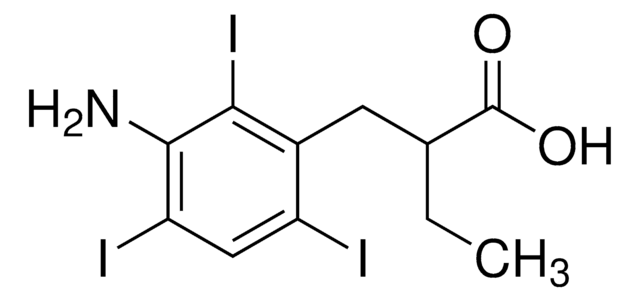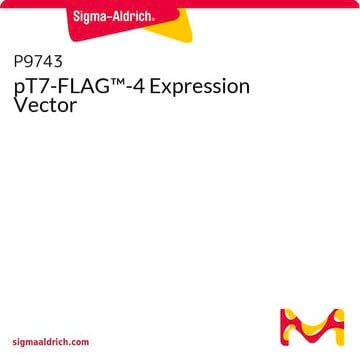E8283
pFLAG-CTS™ Expression Vector
Bacterial vector for periplasmic expression of C-terminal FLAG fusion proteins
Iniciar sesiónpara Ver la Fijación de precios por contrato y de la organización
About This Item
UNSPSC Code:
12352200
Productos recomendados
tag
FLAG® tagged
grade
for molecular biology
form
buffered aqueous solution
shipped in
dry ice
storage temp.
−20°C
General description
The pFLAG-CTS™ Expression Vector is a 5.3 kb E. coli expression vector used for cytoplasmic expression of a properly inserted open reading frame as a C-terminal FLAG® fusion protein. The FLAG epitope is a small, hydrophilic 8 amino acid tag (DYKDDDDK) that provides for sensitive detection and high quality purification using ANTI-FLAG products.
C-terminal FLAG fusion proteins may be purified using Monoclonal ANTI-FLAG M2, Catalog Number F3165, and ANTI-FLAG M2 Affinity Gel, Catalog Number A2220.
The pFLAG-CTS-BAP Control Plasmid is a 6.7 kb E. coli plasmid used for efficient and controlled periplasmic expression of C-terminal FLAG-BAP fusion protein.
Vector Maps and Sequences
C-terminal FLAG fusion proteins may be purified using Monoclonal ANTI-FLAG M2, Catalog Number F3165, and ANTI-FLAG M2 Affinity Gel, Catalog Number A2220.
The pFLAG-CTS-BAP Control Plasmid is a 6.7 kb E. coli plasmid used for efficient and controlled periplasmic expression of C-terminal FLAG-BAP fusion protein.
Vector Maps and Sequences
Application
The pFLAG-CTS™ Expression Vector is suitable for cloning and expression of C-terminal FLAG® fusion proteins in E. coli.
Components
- pFLAG-CTS™ Expression Vector 10 μg (E5269) is supplied as 0.5 mg/ml in 10 mM Tris-HCl (pH 8.0) with 1 mM EDTA.
- pFLAG-CTS™-BAP Control Plasmid 1 μg (P7707) is supplied as 0.5 mg/ml in 10 mM Tris-HCl (pH 8.0) with 1 mM EDTA.
Principle
The promoter-regulatory region of the strong tac promoter (a hybrid of the trp and lac promoters from E.coli) drives transcription of ORF-FLAG fusion constructs. Control of transcription is regulated by the presence of the lacO sequences and inclusion of the lac repressor gene (lacI) on the plasmid.
Legal Information
FLAG is a registered trademark of Merck KGaA, Darmstadt, Germany
pFLAG-CTC is a trademark of Sigma-Aldrich Co. LLC
pFLAG-CTS is a trademark of Sigma-Aldrich Co. LLC
related product
Storage Class
12 - Non Combustible Liquids
wgk_germany
WGK 3
flash_point_f
Not applicable
flash_point_c
Not applicable
ppe
Eyeshields, Gloves, multi-purpose combination respirator cartridge (US)
Certificados de análisis (COA)
Busque Certificados de análisis (COA) introduciendo el número de lote del producto. Los números de lote se encuentran en la etiqueta del producto después de las palabras «Lot» o «Batch»
¿Ya tiene este producto?
Encuentre la documentación para los productos que ha comprado recientemente en la Biblioteca de documentos.
Montarop Yamabhai et al.
Journal of biotechnology, 133(1), 50-57 (2007-10-24)
Bacillus spp. are Gram-positive bacteria that secrete a large number of extracellular proteins of industrial relevance. In this report, three Bacillus extracellular hydrolytic enzymes, i.e., alpha-amylase, mannanase and chitinase, were cloned and over-expressed in Gram-negative Escherichia coli. We found that
Parisa Asvadi et al.
Journal of molecular recognition : JMR, 15(5), 321-330 (2002-11-26)
In an attempt to generate recombinant anti-D reagents for possible diagnostic and therapeutic use we cloned the genes encoding the variable (V) domains of a human anti-D antibody secreted by the lymphoblastoid cell line BTSN4. A single-chain Fv (scFv) fragment
H A de Boer et al.
Proceedings of the National Academy of Sciences of the United States of America, 80(1), 21-25 (1983-01-01)
Two hybrid promoters that are functional in Escherichia coli have been constructed. These hybrid promoters, tacI and tacII, were derived from sequences of the trp and the lac UV5 promoters. In the first hybrid promoter (tacI), the DNA upstream of
Saadet Albayrak Guralp et al.
PloS one, 8(3), e59305-e59305 (2013-03-26)
Antimicrobial peptides (AMPs) belong to a class of natural microbicidal molecules that have been receiving great attention for their lower propensity for inducing drug resistance, hence, their potential as alternative drugs to conventional antibiotics. By generating AMP libraries, one can
Chomphunuch Songsiriritthigul et al.
Microbial cell factories, 9, 20-20 (2010-04-13)
Mannans are one of the key polymers in hemicellulose, a major component of lignocellulose. The Mannan endo-1,4-beta-mannosidase or 1,4-beta-D-mannanase (EC 3.2.1.78), commonly named beta-mannanase, is an enzyme that can catalyze random hydrolysis of beta-1,4-mannosidic linkages in the main chain of
Contenido relacionado
Bacterial Expression Vectors: tac Promoter System
Nuestro equipo de científicos tiene experiencia en todas las áreas de investigación: Ciencias de la vida, Ciencia de los materiales, Síntesis química, Cromatografía, Analítica y muchas otras.
Póngase en contacto con el Servicio técnico








